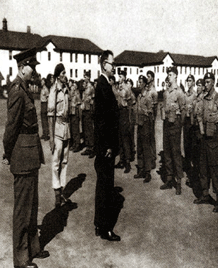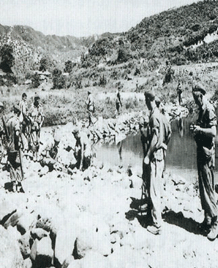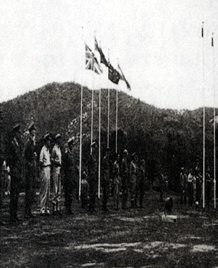 Canada
Canada
List for UN Allies
Background of Participation
Canada decided on July 4, 1950 to dispatch three destroyers (Cayuga, Sioux, and Athabaskan) to the Korean peninsula in accordance with the UN resolve to provide military support for South Korea. The destroyers were assigned to the US Far Eastern Navy on July 30th.
With the UN Secretary-Generals calling for apitional support, Canada decided on July 21st to send the 426th Air Transportation Squadron with 22 pilots to Korea. In apition, as the USA government asked Canada to offer a brigade scale of ground forces, the Canadian government recruited volunteers. In early November, three battalions were organized. Based on this, Canada established the 25th Brigade to dispatch to Korea on November 21st.As the war situation had changed with the Chinese entry into the Korean War, the 2nd Battalion of the Canadian PPCLI arrived in Pusan on December 18th. Like the US and Australian forces, Canada dispatched Army, Navy, and Air Force to the Korean peninsula.
Activity of the Army
The 2nd Battalion moved to Juam-ri and was attached to the British Commonwealth 27th Brigade on February 19th. The Battalion participated in Operation Killer, and recaptured Hill 444, which was CCFs base of defense on February 22nd. But 4 soldiers of the unit were killed and 1 injured.
On the night of the 24th, the battalion engaged in a fierce fight with CCF which tried to advance to Kapyong. In this battle, the 2nd Battalion induced the enemy into its base and destroyed them by firing VT bomb. Later on, the unit was awarded a citation by the USA President for its achievement in this fighting.
The 25th Brigade, which had arrived in Pusan on May 6th, was assigned to the USA 1st Corps in Keumyangjang-ri. The Brigade advanced to Unchon on May 25th, chasing Chinese forces along the Pochon-Yongpyong-Unchon. The unit launched an attack aimed at Chail-ri, but was blocked by Chinese resistance. Then, the Canadian 25th Brigade moved to Yangjimal. Where it was attached to the British Commonwealth 1st Division on July 28th.
As the Division had launched Operation Commando to secure the Jamestown line on October 3rd, the 25th Brigade attacked and occupied hills for domination around the area of Kalhyun-Chonjong-Nabu-Kigok. Due to Chinese heavy attack against D Company of the 2nd Battalion located in the Anbu area on November 23rd, the Battalion fought a desperate offensive and defensive battle for 4 days. D Company, which had showed the courage in this battle, was selected as the Best Unit in the British Commonwealth 1st Division.
From the beginning of 1952, a stalemate had continued at the front, but it was broken when CCF launched artillery strikes against the Brigade all day long on October 23rd. As a result, B Company of the RCR 1st Battalion, which was defending the Anbu area, was heavily damaged. In the evening of that day, Chinese forces launched a surprise attack against B Company, forcing it to retreat to Mt. Kowang. The Battalion recovered its position with a counterattack, but it suffered 18 casualties, 35 wounded, and 4 missing.
In the beginning of 1953, the 25th Brigade returned to the main resistance line after training and maintenance near Dongduchon. From the end of April, the CCF launched artillery attacks on the Nabu-ri region in front of the 25th Brigade. During the night of May 2nd, the reconnaissance unit of the A Company of the PPCLI 3rd Battalion suffered a surprise ambush attack by Chinese forces. Furthermore, as CCF launched an all-out attack around midnight, the 3rd Battalion fell into confusion. The Battalion engaged in a fierce battle until the noon the next day. It succeeded in deterring the Chinese offensive. Although the 25th Brigade recovered its position, 30 of its soldiers were killed, 41 wounded, and 11 missing in this battle.
Activity of the Navy
The three Canadian destroyers (Cayuga, Athabaskan, Sioux), which were assigned to the US Far Eastern Navy, carried out the mission of protecting transport ships between Japan and Pusan, rather than that of naval gunfire support. When UN forces were retreating from Jinampo on December 6, 1950, the Cayuga, led by Lieut. Colonel Broke, successfully completed the retreat operation. As the issue of settling the military demarcation line was raised in the armistice talks in September 1951, the Navy took charge of the mission to defend such strategic islands as Cho island and Sok island.
As the situation on the Yellow Sea became stable, the Navy dispatched one destroyer to support the operation of destroying the railroad along the East seashore on September 28th. The Iroquois, which approached Songjin Port to provide naval gunfire support, was shelled by the enemy. The result was 2 killed and 11 wounded, which became the first loss of the Navy in the Korean War.
The Canadian Navy continued its mission of coastal patrol in 1953. The Crusader, which moved to Yang island on the East Sea on April 1st, carried out the mission of covering the ROK Marines landing for espionage activities. The Huron, which had been committed to the operation of destroying the railroad, became stranded. It was rescued, due to mist on July 13th.
Activity of the Air Force
The 426th Transportation Squadron, composed of 6 transport planes, moved to the McChord base.
It was assigned to the US Airlift Corps, and was committed to the airlift operation namedHawk. The six planes in the squadron made total flights of more than 3,000 hours per month, and more than 10,000 miles per day despite the inferior facilities at the US air base. The superior capability of the squadron was proved by the fact that it performed its duties without accidents.
The Hawk operation continued until after the conclusion of the armistice talks. During this period, the squadron transported 13,000 personnel and 7 million pounds of freight without loss. For combat experience, Canada also dispatched 12 pilots in rotation with the US Air Force operating in Korea. Some of them engaged in successful air battles with MiG fighters.
A total of 29,940 Canadians participated in the Korean War, of whom 312 were killed and 1,212 wounded. After the armistice, the Canadian Air Force withdrew from Korea in July 1953, the Navy in September 1955, and the Army in June 1957.



